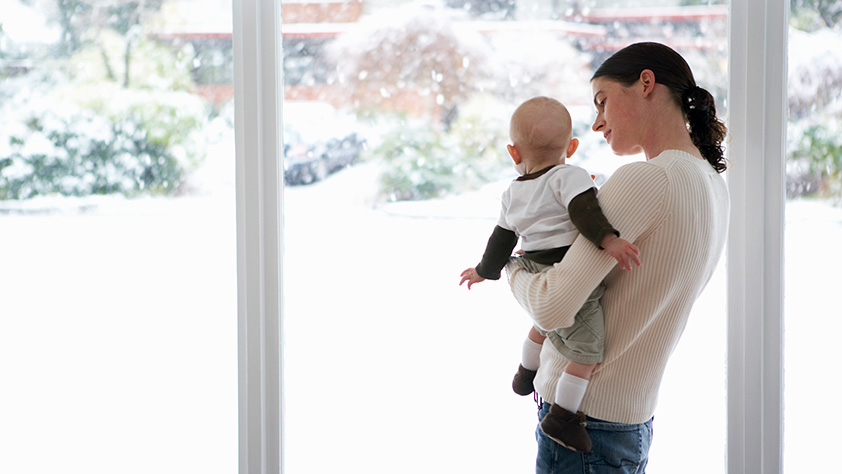Now that fall is here, it’s time to prepare your home for cold weather. These steps will lower your utility bills and protect your investment—and you can do most of them yourself.
Tune up your heating system
For about $80 to $100, a technician will inspect your furnace or heat pump to be sure the system is clean and in good repair and that it can achieve its manufacturer-rated efficiency. The inspection also measures carbon-monoxide leakage.
Make an appointment soon to minimize the chance of being 200th in line for repairs on the coldest day of the year. Look for a heating and air-conditioning contractor that belongs to the Air Conditioning Contractors of America and employs technicians certified by the North American Technician Excellence program. The contractor should follow the protocol for ACCAs “national standard for residential maintenance” (or the QM, short for “quality maintenance”).
Reverse your ceiling fans
If your ceiling fan has a reverse switch, use it to run the fan’s blades in a clockwise direction after you turn on your heat. Energy Star says the fan will produce an updraft and push down heated air from the ceiling (remember, hot air rises) into the room.
This is especially helpful in rooms with high ceilings—and it might even allow you to turn down your thermostat by a degree or two for greater energy savings.
Prevent ice dams
If your home had lots of icicles last winter—or worse, ice dams, which can cause meltwater to back up and flow into your house—take steps to prevent potential damage this year.
A home-energy auditor or weatherization contractor can identify and fix air leaks and inadequate insulation in your home’s attic that can lead to ice dams.
Hit the roof
Or at least scan it closely with binoculars. Look for damaged, loose or missing shingles that may leak during winter’s storms or from melting snow.
If needed, hire a handyman to repair a few shingles (roughly $95 to $127, according to CostHelper) or a roofer for a larger section ($100 to $350 for a 100-square-foot area). Check and repair breaks and gaps in the flashing seals around vent stacks and chimneys, too.
If your roof is flat and surfaced with asphalt and pebbles, as many are in the Southwest, rake or blow off fall leaves and pine needles, which hold moisture, says Bill Richardson, past president of the American Society of Home Inspectors, in Albuquerque. (Don’t sweep aside the pebbles; that will expose the asphalt to damaging sunlight.)
Caulk around windows and doors
Richardson says that if the gaps between siding and window or door frames are bigger than the width of a nickel, you need to reapply exterior caulk. (Check the joints in window and door frames, too.) Silicone caulk is best for exterior use because it won’t shrink, and it’s impervious to the elements.
Try GE’s Silicone II Window and Door product, which is “rain ready” in three hours (about $6 at The Home Depot). Check window-glazing putty, too; it seals glass into the window frame. Add weatherstripping as needed around doors, making sure that you can’t see any daylight through gaps from inside your home.
Clean the gutters
If your gutters are full of detritus, water can back up against the house and damage roofing, siding and wood trim—plus cause leaks and ice dams.
You’ll typically pay $70 to $225 to clean gutters on a single-story house, depending on its size. Also look for missing or damaged gutters and fascia boards so you can repair them.
Divert water
Add extensions to downspouts so that water runs at least 3 to 4 feet away from the foundation, says David Lupberger, a home-improvement expert. The Home Depot sells the Amerimax Flex-a-Spout extension (which extends 25 to 55 inches) for about $9.
Turn off exterior faucets
Undrained water in pipes can freeze, which will cause pipes to burst as the ice expands. Start by disconnecting all garden hoses and draining the water that remains in faucets.
If you don’t have frost-proof faucets (homes more than 10 to 15 years old typically do not), turn off the shut-off valve inside your home.
Drain your lawn-irrigation system
Draining sprinkler-system pipes, as with spigots, will help avoid freezing and leaks. But call in a professional to do the job. Your sprinkler service likely will charge about $75 to $150, depending on the size of the system.
Mulch leaves when you mow
Mow your leaves instead of raking them, say studies at the University of Michigan and Purdue. The trick is to cut the leaves, while dry, into dime-sized pieces that will fall among the grass blades, where they will decompose and nourish your lawn over the winter.
Use your lawn mower without its bag, and optionally swap the cutting blade for a mulching blade (about $15 to $20). The process may take several passes.
Prepare to stow your mower
As the mower sits through the winter, fuel remaining in its engine will decompose, “varnishing” the carburetor and causing difficulty when you try to start the engine in the spring.
Lawn care manufacturer John Deere offers these preventive steps: If you’ve added stabilizer to your fuel to keep it fresh longer, then fill the gas tank to the top with more stabilized fuel and run the engine briefly to allow it to circulate. If not, wait until the tank is nearly empty from use and run the engine outdoors to use up the remaining fuel.
Check your mower’s manual for more cold-weather storage steps.
Test your sump pump
Slowly pour several gallons of water into the sump pit to see whether the pump turns on. You should do this every few months, but especially after a long dry season or before a rainy one.
For more complete instructions for testing and maintenance, check your owner’s manual. Most sump pumps last about 10 years, according to Chubb Personal Insurance.
Call a chimney sweep
Before you burn the yule log, make sure your fireplace (or any heating appliance burning gas, oil, wood or coal), chimney and vents are clean and in good repair. That will prevent chimney fires and prevent carbon monoxide from creeping into your home.
Search for a sweep certified by the Chimney Safety Institute of America. You can expect to pay $50 to $90 for an inspection to see if you need a cleaning, and $100 to $300 for the cleaning, according to CostOwl.com.
Restock winter essentials
Don’t wait for the first winter storm to restock cold-weather essentials, such as salt or ice melt. If you can’t abide a snowblower’s roar or the back-breaking workout of shoveling, check out the Snow Wolf, a wheeled shovel that does much of the heavy-lifting for you ($179.90; wovel.com).
Skip pruning trees and shrubs for now
You may be tempted to get out the pruning shears after the leaves fall of the trees, when you can first see the underlying structure of the plant. But horticulturalists advise waiting to prune until late winter for most plants, when they’ve been long dormant and just before spring growth begins.
To get advice specific to your plants and region, consult master gardeners at local nurseries or horticulturalists with your state university’s cooperation extension department. One exception: You may need to hire an arborist to remove deadfall or trim back limbs that are close to your home or power lines that could cause problems in a winter storm.
Content provided by:













